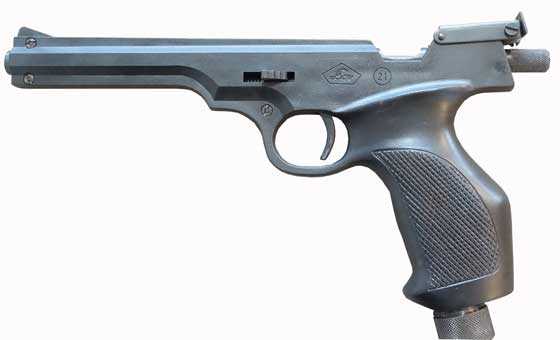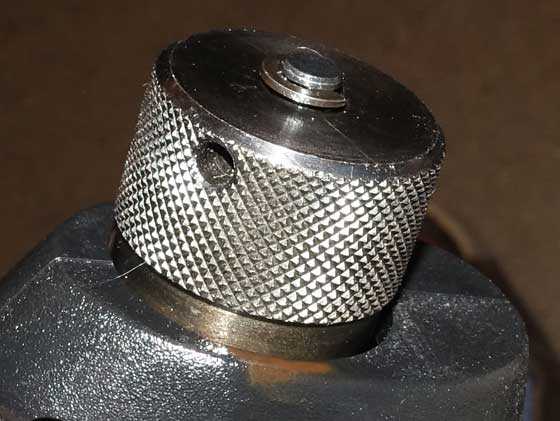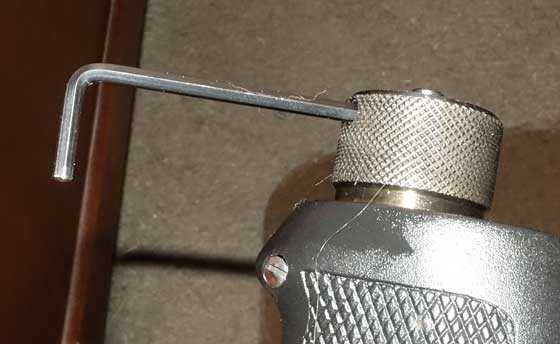by Tom Gaylord
Writing as B.B. Pelletier

The Lov 21 is a CO2 target pistol; made in the Czech Republic. It doesn’t look like much, but people speak well of it in Canada and Europe.
This report covers:
- Learned a lot!
- The CO2 cap
- Velocity — H&N Finale Match light
- JSB Exact RS
- Sig Match Ballistic Alloy
- Shot count
- Trigger
- Evaluation
Learned a lot!
We learned a lot from new European readers’ comments to Part 1 of this report — especially reader H3P04. I told you the Lov 21 is an air pistol that I am completely unfamiliar with, and from the little I do know so far, it seems like a winner. Today we start finding out.
The first thing we learned is this pistol isn’t even mainstream in its country of origin! They know about it, but it doesn’t stand out, according to the comments made by several Czech readers.
The CO2 cap
I was asked by H3P04 to show the bottom of the CO2 cap, so here it is.

As you can see, there are no threads on the end of the cap, so it is not a bulk-fill cap — just a CO2 cartridge cap. The hole in the knurled side allows a bar to be inserted for more leverage when piercing the cartridge.
How was I able to pierce the CO2 cartridge, when the pin inside the cap is flat? There is a hole on the side of the piercing cap that accepts a small bar. Stick an Allen wrench in the hole and you multiply the force with which you turn the cap to the extent that a flat pin can be driven into a steel CO2 cylinder.

The Allen wrench in the hole gives a lot more leverage for piercing the cartridge.
Velocity — H&N Finale Match light
The first pellet I tested was the H&N Finale Match light with a 4.50mm head. They averaged 436 f.p.s. for 10 shots. The low was 433 and the high was 440 f.p.s., so a 7 f.p.s. spread. That is extremely tight for CO2. It borders on the consistency of a regulated PCP! I waited no longer than 10 seconds between shots, and only that slow because the Lov 21 is a single shot pistol with a lot to do to get the next shot ready. It seems safe to say the Lov 21 is not affected by the cooling of CO2 gas, which is a bigplus in a target pistol.
JSB Exact RS
I knew readers would want to see something more than just target pellets, So I tested the JSB Exact RS dome. It’s an accurate pellet that I would try in this pistol anyway. They averaged 443 f.p.s. with a 12 f.p.s. spread that ran from 435 to 447 f.p.s. That’s still pretty tight. I will shoot them for accuracy, as well.
Sig Match Ballistic Alloy
The last pellet I tried was the Sig Match Ballistic Alloy pellet. Weighing 5.25-grains I know this pellet will give higher velocity than the lead pellets. That isn’t necessarily a desirable feature in a target airguns. As long as the pellets move fast enough to cut clean holes in target paper, no additional velocity is required.
These pellets averaged 493 f.p.s. The low was 476 and the high was 500 f.p.s., so the spread was 24 f.p.s. The first shot was the only one that was below 492 f.p.s., so there might have been some first-shot dynamic happening, though I didn’t see it with the other two pellets.
Shot count
As brisk as this pistol is, how many shots might you get on a CO2 cartridge? At this point in the test I had fired 36 shots, so I continued with H&N Finale Match (436 average) and got the following results.
Shot……….Velocity
40……………432
45……………432
50……………428
55……………427
60……………422
65……………417
70……………419
75……………423
80……………411
85……………400
90……………383
95……………353
Looking at this string I would have thought the gun was out of steam by shot 65, but look what happened. It picked back up again and did well until shot 80. Know what that tells me? It tells me I can shoot a men’s 10-meter match (60 shots) and still have several sighters at the start. A women’s match of 40 shots is assured. At least that’s possible with this cartridge. Not every cartridge will have that much gas, so you might want to be more conservative, but I think there will always safely be 60 shots in a cartridge.
Trigger
The Lov 21 has a single-stage trigger. I told you in Part 1 that I thought it broke so light I would need to test it for safety from accidental discharge. This time I cocked the gun then bumped it severely in several directions and it never fired. I don’t like a single stage trigger that’s also light, but this one passes the test.
The trigger broke at 1 lb. 4.5 oz. average. It ranged from 1 lb. 3 oz. to 1 lb. 8 oz. I feel some creep in the pull, but it’s not too bad. I can do good work with this trigger.
Evaluation
So far the Lov 21 is showing a lot of good engineering. The one bad thing is the maker selected o-rings of the wrong material. They absorb CO2 gas and swell to much larger than their relaxed size. That makes it practically impossible to remove the CO2 cap until the gun has been depressurized for several hours, giving the gas time to bleed out of the o-ring. American gas guns had the same problem back in the 1950s, but when they found a material that sealed but did not absorb gas, they made the change. That problem was over by the 1960s.
Perhaps the Lov 21 engineers are paying it safe with this material. It certainly won’t leak! But it also means you cannot install another CO2 cartridge until several hours have passed. Also you must shoot out all the gas, as there is no other way to depressurize the gun.